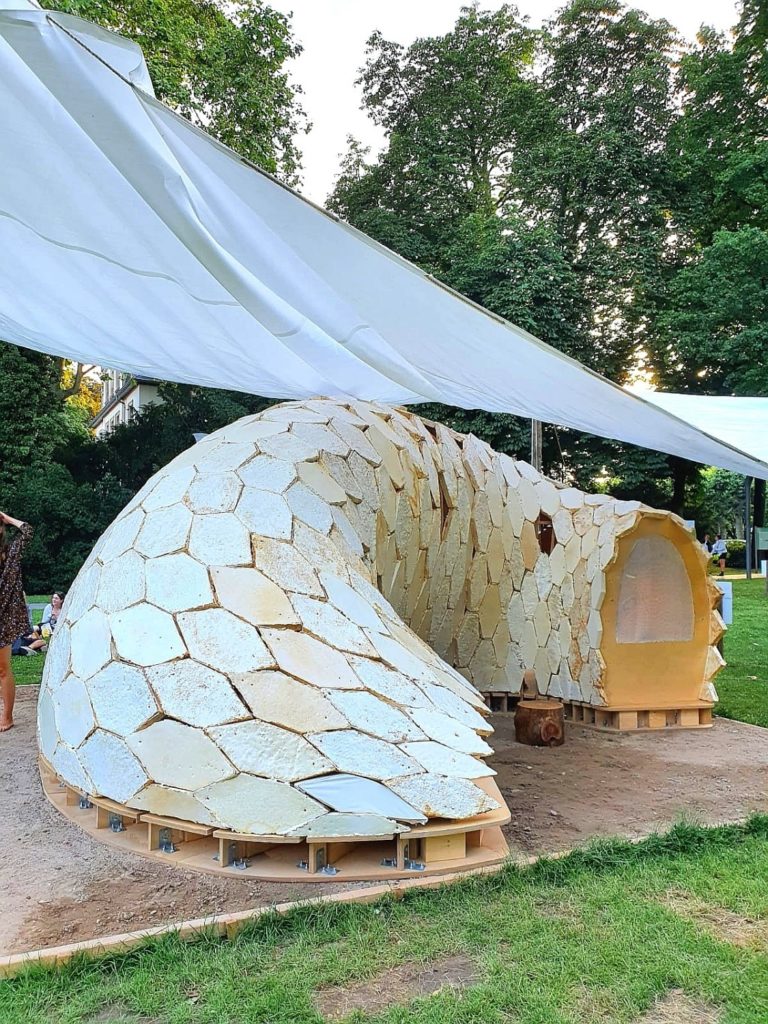
So what is this about again?
Currently, the tinyBE platform is making a name for itself. The initiative sees itself as a global platform that enables various actors to speculate on new, alternative and sustainable ways of living in public space and to make the results touchable for visitors. The current exhibition opened on 26.06.2021 and will run until 26.09.2021. The exhibited works are not only to be viewed from the outside, but it is also possible to spend a night there and experience sustainable living, at least for a short time.
MY-CO SPACE
Those who know me, know that I find fungi fascinating. Not only because of their extraordinary ecological role in nature, but also and especially because of the future importance of fungi for circular economic processes. A small catastrophe for the climate is indeed also the increasing demand for apartments, houses with still increasing human population. The resources needed for this, such as cement, sand and water are not only scarce, but also burden the climate. Among other things, this is exactly the problem that the SciArt collective MY-CO-X takes on, who are also exhibitors at tinyBE this year with their MY-CO SPACE. MY-CO-X was founded by the university professor Vera Meyer, who is also known as an artist under the name V. meer, together with the architect Sven Pfeiffer.

The MY-CO SPACE house consists of a supporting wooden structure covered with mushroom panels. The fungal outer shell is grown from biological materials and is therefore completely biodegradable. Guests can retire or immerse themselves in studies on about 20 m². The house is not designed to be closed, but its construction communicates constant contact with the outside world. The design is based on the Soviet space station Mir of the Apollo-Soyuz program.
Circular economy
Our planetary resources are limited. New circular economies are being discussed again and again to address resource scarcity. For example, in some of my older posts, I touched on the use of mushrooms in various industries. Among others, the building materials industry, packaging industry, insulation and insulating materials, leather industry and many more. The idea behind this is that naturally grown and used raw materials are added back to the economy after their period of existence has expired, just like in a cycle. The biodegradability of mushroom mycelium is ideal to be used under such conditions. And you know what the best part is? Nature shows us how to do it every day! Symbiotic systems between plants, animals, microorganisms and fungi are the basis for the largest circular system in the world. No biomass is wasted and everything finds its way back into nature.

MY-CO SPACE: Not only inspired on the outside by the Funga!
What the MY-CO-X collective represents particularly well, in my opinion, are the links between nature and humans, as well as humans among themselves, on a personal as well as social level. This process does not stop at the outer shell, but continues especially in the interior: hand-woven carpets dyed with natural fungal pigments (Birke Weber) take us back to a time when humans still lived from and especially with nature in co-existence. On a human-human level, MY-CO-X also signals in particular the ability of people of different professional and personal backgrounds to work together. The trans-disciplinary collaboration has brought together artists, architects and fungal biotechnologists. Disciplines that otherwise have little to do with each other have found common ground here and speak a common language.
And what happens now?
The MY-CO-X mushroom house is not built to last forever. And that is a good thing. But what should stick in people’s minds is the message: The planetary problems, climate change and scarcity of resources can only be solved globally and socially. We need more creative collectives, like MY-CO-X, which, inspired by the natural processes in nature, tackle partly human-made problems and find meaningful solutions for them!
This project can still be seen at tinyBE in Metzlerpark, Frankfurt am Main, until 26.09.2021. If this is not enough for one or the other individual, there are still some inspiring articles on the topics addressed, which I have linked here.
MY-CO SPACE – Designing for Co-Habitation
MY-CO SPACE – The world of fungi
MY-CO-BUILD 2021 – 2022 & Futurium
Studio Sven Pfeiffer (Website)
Applied and Molecular Biotechnology – TU Berlin (Website)
Birke Weber (Instagram Account)
Kustrim Cerimi
Latest posts by Kustrim Cerimi (see all)
- Connecting materials science with fungal biology: A personal insight - 15th June 2022
- Fungal pigments from the perspective of a scientist with passion for tattoos - 25th April 2022
- Fungal metabolites in pre- and postnatal human nutrition: How they may affect us and what to do about it - 25th March 2022
Comments